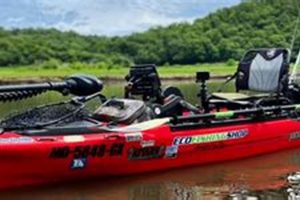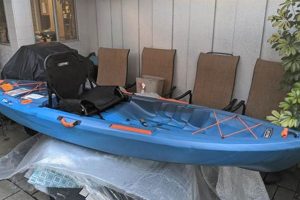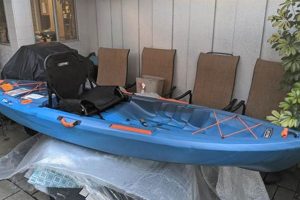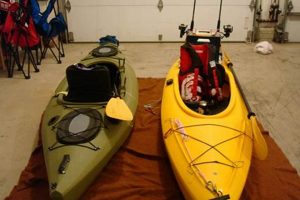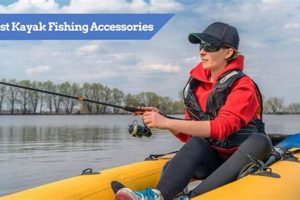Equipment designed specifically for use with sit-on-top fishing kayaks enhances angler safety, comfort, and effectiveness. Examples include rod holders, anchor trolleys, and specialized storage compartments for tackle and gear. These items are typically constructed from durable, weather-resistant materials like marine-grade plastics, stainless steel, and high-strength fabrics.
Enhanced stability and open deck design make sit-on-top kayaks popular for fishing. Purpose-built gear improves the fishing experience by providing readily accessible equipment, reducing clutter, and increasing angler safety in various water conditions. Historically, kayak anglers relied on adapted gear; however, the growing popularity of the sport has driven innovation and the development of specialized equipment. This evolution has resulted in improved functionality, durability, and integration with kayak designs.
This article will explore various categories of equipment designed for sit-on-top fishing kayaks, including storage solutions, navigational aids, safety devices, and comfort enhancements. It will further examine factors to consider when selecting these items, such as material quality, compatibility with specific kayak models, and individual angler preferences.
Essential Tips for Equipping a Sit-On-Top Fishing Kayak
Proper equipment selection significantly impacts fishing success and safety. Consider these recommendations for optimizing a sit-on-top fishing kayak.
Tip 1: Prioritize Stability: Begin with stability enhancements like outriggers or stabilizers if increased stability is desired, especially in challenging conditions or for anglers new to kayak fishing.
Tip 2: Secure Gear Strategically: Employ rod holders, tackle storage, and anchor trolleys to keep essential gear organized and within easy reach. This minimizes movement and maximizes fishing time.
Tip 3: Choose Appropriate Personal Flotation Devices (PFDs): Select a comfortable, fishing-specific PFD with ample pockets for small tools and accessories. Ensure it adheres to relevant safety standards.
Tip 4: Consider Visibility and Safety: Enhance visibility with bright-colored kayak flags, especially in high-traffic areas or low-light conditions. Carry a whistle or air horn for signaling in emergencies.
Tip 5: Plan for Water Resistance: Protect electronic devices and valuable items with waterproof cases or dry bags. Choose water-resistant or quick-drying materials for clothing and gear.
Tip 6: Optimize Paddle Choice: Select a paddle appropriate for kayak width and angler height. Consider a lightweight paddle with a comfortable grip for extended paddling sessions.
Tip 7: Invest in a Quality Anchor System: Choose an anchor appropriate for the fishing environment and bottom composition. An anchor trolley system allows for efficient anchor deployment and retrieval.
Careful selection and strategic placement of equipment contribute significantly to a safe and productive kayak fishing experience. These tips aim to improve angler preparedness and enjoyment on the water.
By following these guidelines, anglers can confidently focus on the fishing experience, knowing their equipment is optimized for safety, efficiency, and enjoyment. The next section will discuss specific product recommendations within each equipment category.
1. Rod Holders
Rod holders constitute a critical component within the broader category of sit-on-top fishing kayak accessories. Their primary function is to secure fishing rods, allowing anglers to perform other tasks such as paddling, adjusting tackle, or landing fish. Without dedicated rod holders, rods would need to be held constantly or laid on the kayak’s deck, increasing the risk of loss or damage. This highlights the direct causal relationship between utilizing rod holders and enhancing both efficiency and safety during kayak fishing. For example, an angler navigating through challenging currents or attempting to land a large fish benefits significantly from having rods securely stored and readily accessible. Fixed, adjustable, and rotating rod holder designs cater to different fishing techniques and preferences.
The practical significance of incorporating rod holders becomes further evident when considering specific fishing scenarios. Trolling multiple lines requires multiple rod holders positioned strategically to prevent line tangling. Similarly, when fishing in areas with submerged obstacles or strong currents, securing rods minimizes the risk of entanglement or breakage. Selecting appropriate rod holders depends on factors like fishing style, target species, and kayak model. Flush-mount rod holders offer a streamlined profile for paddling, while adjustable rod holders provide versatility for different fishing angles. Rotating rod holders allow for quick adjustments when fighting fish. Careful consideration of these factors ensures optimal rod placement and accessibility, maximizing fishing success and minimizing equipment-related challenges.
Integration of rod holders exemplifies the overall importance of specialized accessories in enhancing sit-on-top kayak fishing. They contribute directly to improved safety, efficiency, and enjoyment on the water. Challenges such as limited deck space and compatibility with specific kayak models necessitate careful planning and selection of rod holders. However, the advantages offered by these accessories, including hands-free fishing and reduced equipment damage, significantly outweigh these challenges for most anglers. Properly chosen and installed rod holders empower anglers to focus on the core aspects of fishing, enhancing their overall experience.
2. Anchor Systems
Anchor systems represent a crucial subset of sit-on-top fishing kayak accessories, directly influencing an angler’s ability to maintain position and effectively target fish. A properly configured anchor system prevents drift caused by wind, current, or tide, enabling precise boat control. This stability becomes particularly significant when fishing specific locations like drop-offs, reefs, or other underwater structures. Without an anchor, maintaining position in these areas proves challenging, hindering fishing effectiveness. Consider, for example, a scenario involving bottom fishing in a current-swept river channel. An anchor system allows the angler to hold the kayak steady over the desired fishing spot, maximizing fishing opportunities. Conversely, the absence of an anchor would result in constant drift, reducing fishing effectiveness and potentially leading to snags or lost tackle.
Several anchor system types cater to varying kayak fishing needs. Lightweight folding anchors suit calmer waters, while heavier grapple anchors provide superior holding power in stronger currents or rocky environments. The deployment method also influences anchor system effectiveness. A simple anchor trolley system, consisting of a line running along the kayak’s gunwales, allows anglers to adjust anchor position and control drift direction. This adaptability proves invaluable when fishing in changing conditions. For instance, an angler fishing along a shoreline might adjust the anchor position to follow contours or target specific features. More sophisticated anchor systems incorporate pulleys and cleats for refined control and retrieval. Understanding these variations allows anglers to select the most appropriate setup based on fishing environment, kayak type, and personal preference.
Effective anchor deployment contributes significantly to efficient and safe kayak fishing. Challenges associated with anchor systems include potential entanglement, anchor retrieval difficulties, and storage considerations on smaller kayaks. Despite these challenges, the benefits of precise boat control, enhanced fishing effectiveness, and increased safety in various water conditions underscore the importance of anchor systems as a core component of sit-on-top fishing kayak accessories. Integrating an appropriate anchor system empowers anglers to optimize their fishing experience by maximizing time spent fishing in desired locations, ultimately increasing the likelihood of success. This understanding allows for informed decisions regarding anchor system selection and utilization, contributing to safer and more productive fishing excursions.
3. Storage Solutions
Effective storage solutions are integral to sit-on-top fishing kayak accessories, directly impacting organization, accessibility, and overall fishing success. Limited deck space necessitates efficient storage to prevent clutter and ensure essential gear remains readily available. Proper organization contributes significantly to a safe and productive fishing experience. Storage solutions specifically designed for kayaks maximize available space and secure gear against the elements.
- Tackle Management:
Tackle boxes, trays, and bags designed for kayak fishing offer specialized compartments and waterproof construction to protect lures, hooks, and other small items. Modular systems allow anglers to customize storage configurations based on specific needs. For instance, a bass angler might prioritize compartments for soft plastics, while a saltwater angler may require specialized storage for saltwater-resistant tackle. Efficient tackle management prevents tangles, streamlines lure selection, and minimizes time spent searching for specific items.
- Rod and Paddle Storage:
Dedicated rod holders and paddle clips secure these essential items when not in use, preventing loss or damage. Secure storage allows for unobstructed paddling and casting, enhancing both safety and efficiency. For example, securely stored rods minimize the risk of entanglement while navigating through vegetation or landing a fish. Similarly, readily accessible paddles ensure quick reactions in changing water conditions. Strategic placement of rod and paddle storage facilitates smooth transitions between paddling and fishing.
- Dry Storage Compartments:
Waterproof hatches and compartments protect sensitive items like electronics, wallets, and keys from water damage. These compartments provide essential protection against splashes, rain, and even accidental submersion. For example, storing a cell phone in a dry bag within a dedicated compartment ensures its functionality even after unexpected exposure to water. Dry storage compartments maintain the integrity of essential gear, contributing to safety and peace of mind during fishing excursions.
- Gear Crates and Bags:
Durable, waterproof crates and bags provide versatile storage for larger items like safety equipment, extra clothing, and food. These solutions often integrate with existing kayak features or can be secured to deck rigging. For example, a gear crate secured behind the seat can hold a first-aid kit, rain gear, and other essentials, maximizing deck space and ensuring easy access. Strategic utilization of crates and bags maximizes storage capacity while maintaining a balanced and stable kayak setup.
Integrating these various storage solutions creates an organized and efficient kayak fishing platform. By strategically utilizing specialized compartments, securing essential gear, and protecting sensitive items from water damage, anglers enhance both safety and fishing success. The ability to quickly locate and deploy necessary equipment contributes to a more enjoyable and productive experience on the water, reinforcing the importance of storage solutions as key components of sit-on-top fishing kayak accessories.
4. Safety Equipment
Safety equipment represents a critical category within sit-on-top fishing kayak accessories, directly impacting angler well-being and preparedness for unexpected situations. While the focus often rests on enhancing fishing capability, prioritizing safety ensures a responsible and enjoyable experience on the water. Understanding and utilizing appropriate safety equipment mitigates risks inherent in the kayak fishing environment.
- Personal Flotation Devices (PFDs):
PFDs are fundamental safety items for any kayak angler. A properly fitted PFD provides buoyancy and support in the event of capsizing or accidental immersion. Fishing-specific PFDs often incorporate features like high-visibility colors, multiple pockets for small tools and accessories, and designs that allow for comfortable casting and paddling. Selecting a PFD that adheres to relevant safety standards and fits comfortably is paramount. For example, an angler fishing in cold water might choose a PFD with added insulation for increased thermal protection.
- Signaling Devices:
Signaling devices enable communication in emergencies. Whistles, air horns, and flares attract attention and alert others to potential distress situations. Carrying these devices and understanding their proper use is crucial for effective communication in remote locations or challenging conditions. For instance, a whistle can signal for assistance in the event of a capsize, while a flare can be used to attract attention from a greater distance in foggy conditions or at night.
- Navigation and Communication Equipment:
Navigation aids like GPS units, compasses, and charts aid in maintaining orientation and planning routes, particularly in unfamiliar waters or during extended trips. Communication devices like VHF radios or satellite messengers enable contact with emergency services or shore support. These tools contribute significantly to situational awareness and provide crucial communication channels. For example, a GPS unit can help anglers navigate through fog or track their position in relation to changing tides, while a VHF radio allows for communication with the Coast Guard or other boaters in the area.
- Safety Accessories:
Additional safety accessories further enhance preparedness. A first-aid kit equipped to address common kayak fishing injuries, a knife for cutting lines or releasing entanglement, and a bilge pump for removing water from the kayak’s hull all contribute to a safer environment. These items address specific risks associated with kayak fishing and provide essential tools for managing unexpected situations. For example, a bilge pump can quickly remove water from the kayak after a large wave washes over the deck, maintaining stability and preventing capsizing.
Careful consideration and integration of safety equipment within the broader context of sit-on-top fishing kayak accessories contribute significantly to responsible angling practices. While focusing on enhancing fishing effectiveness is natural, prioritizing safety ensures a sustainable and enjoyable experience on the water. Proper selection, utilization, and maintenance of safety equipment demonstrate a commitment to personal well-being and responsible enjoyment of the sport.
5. Comfort Enhancements
Comfort enhancements play a crucial role within the broader category of sit-on-top fishing kayak accessories, directly influencing angler endurance, focus, and overall enjoyment. Extended periods on the water, often in exposed conditions, necessitate prioritizing comfort to mitigate fatigue and maximize fishing effectiveness. Discomfort can distract from the fishing experience, reduce reaction time, and even contribute to premature fatigue, potentially impacting safety. Addressing comfort needs through specialized accessories allows anglers to maintain focus and fully enjoy their time on the water. For example, a well-designed seat can significantly reduce back strain and improve posture, allowing for longer, more comfortable fishing sessions. Similarly, strategically placed footrests contribute to stability and overall body support, further enhancing comfort and reducing fatigue.
Several comfort-focused accessories cater specifically to the demands of kayak fishing. Padded seats with adjustable backrests provide crucial support and cushioning, minimizing pressure points and promoting proper posture. Adjustable footrests allow anglers to customize leg positioning for optimal comfort and stability, accommodating varying body sizes and kayak designs. Features like breathable fabrics and moisture-wicking materials enhance comfort in warm weather, while insulated seat covers and hand warmers provide protection against cold conditions. Consider an angler spending a full day trolling offshore; a comfortable, supportive seat becomes essential for maintaining focus and physical stamina throughout the extended fishing period. Similarly, an angler fishing in colder climates benefits significantly from insulated accessories that maintain body warmth and prevent discomfort or cold-related injuries.
Integrating comfort enhancements into a sit-on-top fishing kayak setup demonstrates a proactive approach to angler well-being. While performance-enhancing accessories often take precedence, neglecting comfort can undermine the overall fishing experience. Addressing comfort needs contributes directly to increased endurance, improved focus, and enhanced enjoyment on the water. While challenges such as added weight or cost may factor into accessory choices, the benefits of enhanced comfort often outweigh these considerations, particularly during extended fishing trips or challenging weather conditions. Understanding the importance of comfort enhancements allows anglers to make informed decisions regarding accessory choices, ultimately contributing to a more positive and productive fishing experience.
Frequently Asked Questions about Sit-On-Top Fishing Kayak Accessories
This section addresses common inquiries regarding accessories for sit-on-top fishing kayaks, providing concise and informative responses.
Question 1: What are the most essential accessories for a beginner kayak angler?
A personal flotation device (PFD), a paddle leash, a basic anchor, and a rod holder constitute a fundamental starting point. These address essential safety and functionality requirements.
Question 2: How does one choose an appropriate anchor for a sit-on-top kayak?
Anchor selection depends on factors such as fishing environment (river, lake, ocean), bottom composition (sand, rock, vegetation), and kayak size. Lighter anchors suffice for calmer waters, while heavier anchors are necessary for stronger currents or rocky bottoms.
Question 3: Are specialized storage solutions necessary for kayak fishing?
Specialized storage solutions significantly enhance organization and efficiency on a kayak. Waterproof compartments protect sensitive items, while dedicated tackle storage keeps fishing gear readily accessible, minimizing clutter and maximizing fishing time.
Question 4: How does one ensure compatibility between accessories and a specific kayak model?
Consulting the kayak manufacturer’s specifications and recommendations helps ensure compatibility. Additionally, examining product descriptions and reviews often provides insights into compatibility with various kayak models.
Question 5: What are the key safety considerations when choosing kayak fishing accessories?
Prioritizing visibility through bright colors and reflective elements enhances safety in low-light conditions or high-traffic areas. Ensuring accessories are securely attached to the kayak minimizes the risk of entanglement or loss.
Question 6: How does one maintain and care for kayak fishing accessories?
Regular rinsing with fresh water after each use removes salt, sand, and other debris, prolonging accessory lifespan. Storing accessories in a dry, protected environment prevents damage from UV exposure and moisture.
Careful consideration of these frequently asked questions empowers anglers to make informed decisions regarding accessory selection, contributing to a safer, more organized, and ultimately more enjoyable kayak fishing experience.
The next section will offer concluding thoughts and summarize key takeaways regarding the selection and utilization of sit-on-top fishing kayak accessories.
Conclusion
Exploration of essential equipment categories for sit-on-top fishing kayaks reveals the significant impact of proper accessory selection on safety, efficiency, and overall fishing success. From stability enhancements and strategically placed rod holders to comprehensive storage solutions and crucial safety devices, each element contributes to a more organized, productive, and enjoyable experience on the water. Prioritizing comfort through ergonomic seating and other enhancements further extends fishing endurance and focus. Careful consideration of individual needs, fishing style, and environmental conditions informs appropriate equipment choices.
Investing in appropriate equipment transforms a sit-on-top kayak into a highly effective fishing platform. Understanding the function and benefits of various accessories empowers anglers to make informed decisions, optimizing their kayaks for specific fishing scenarios and maximizing their potential on the water. Continual advancements in kayak design and accessory technology promise further enhancements to the sport, creating exciting opportunities for anglers to refine their approach and deepen their connection with the aquatic environment. This understanding fosters a more responsible, productive, and ultimately more rewarding pursuit of kayak fishing.


